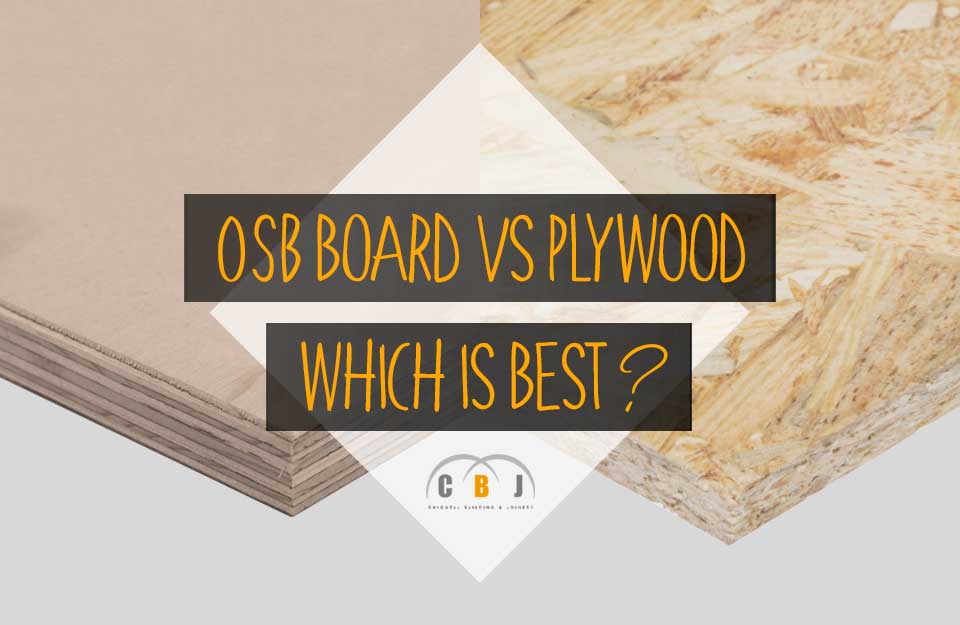News
OSB Board vs Plywood - Which is Best?
Author Chigwell Building & Joinery
Date 04/10/2022
OSB and plywood are engineered woods that can be used alternatively in building construction.
Both products are made from wood, glues and resin, sharing other similarities.
However, this does not mean they are the same nor that they will perform the same in similar applications.
Builders and homeowners should know the difference between these products and their suitable uses.
In this article, we take an in-depth look at OSB and plywood, identifying its differences and helping readers make well-informed decisions.
Table of Contents
- What is OSB (Oriented Strand Board)?
- How Is OSB Made?
- OSB Durability
- OSB Water Resistance
- Pros of OSB
- Cons of OSB
- What is Plywood?
- How is Plywood Made?
- Plywood Durability
- Plywood Water Resistance
- Pros of Plywood
- Cons of Plywood
- Conclusion
What is OSB (Oriented Strand Board)?
Image credit: Wikipedia
Oriented strand board (OSB) is an engineered wood formed from layers of compressed wood strands adhering to a specific orientation.
The individual wood strands are about 2.5 cm x 15 cm and are laid uneven across each other.
It is a popular choice for sheathing, roof decking and flooring, and it is also great for furniture making.
OSB's combination of wood, wax and adhesive makes it durable for structural building work.
It is resistant to warping, delamination and raking.
How Is OSB Made?
Oriented strand board is made of wood that is shredded into strands.
OSB uses trees such as pines, aspen poplar, and other mixed hardwoods.
The process of manufacturing OSB is divided into 5 steps. These are:
- Picking and debarking
- Stranding and drying
- Blending and forming
- Pressing
- Quality control
Picking and Debarking
Oriented strand boards are made from carefully selected trees like pines, aspen poplar, and other hardwoods.
These trees come from a sustainably managed forest.
They are grown and harvested every 10-15 years, making sourcing very sustainable.
After harvesting these trees, they are sent to the manufacturer for debarking.
Debarking means simply removing the bark from the trees.
The removed bark is used as a source of fuel for the drying process.
It is a great eco-friendly process.
Stranding and Drying
Next, the debarked trees are sent to the strander machine.
The strander machine is composed of precision blades moving at 2500 pm.
They are programmed to cut the trees into strands in predetermined dimensions, thicknesses, widths, and lengths.
Once the stranding process is completed, the strands are moved to a dryer.
The dryer is powered by fuel from the debarks of trees.
They are programmed at a certain temperature and help reduce the moisture in the strands.
Note that the dryer does not eliminate the moisture in the strands.
Blending and Forming
Wood strands are moved in for blending and forming.
It involves mixing the strands with adhesive resins (such as urea-formaldehyde; phenol formaldehyde resin on its surface; and poly-methylene diphenyl diisocyanate in the inner region).
Then the wood is bonded together and cut into rectangular mat sizes.
Pressing
Next, the mats are moved onto a presser that could weigh up to two million pounds.
The presser compresses the strands into a single board using up to 7500 psi and over 400 degrees Fahrenheit.
The finished product from here is recognisable as OSB, but the process doesn't end here.
Quality Control
All these processes are carried out in a highly controlled environment.
They ensure that the boards are of similar quality, and they reduce the number of defects.
Computerised processes are employed to reduce human errors.
In the United Kingdom, OSB manufacturing and use are governed by EU standards until January 2023.
OSB must comply with designated EU or UK standards for wood panels, including the (BS)En 13986: 20004+A12015.
OSB Durability
OSB and plywood are durable materials.
The level of durability will vary amongst them.
Regarding how they perform in a moist environment, OSB is slower in absorbing water.
Its resistance to moisture makes it a desirable choice in damp areas.
However, it has been known to swell, especially on the edges and it does not return to its original shape, even after drying.
In terms of strength, OSB is similar to plywood.
It can lift the same weight as plywood.
OSB is heavier than plywood and more consistent.
In summary, OSB is great for home construction and can last a long time if maintained well.
OSB Water Resistance
Quality OSB can resist water damage.
The strands that make up the board are coated with adhesive resin and wax.
These substances give strength, durability, and waterproofing to the OSB.
The OSB grade 1 will resist damage from rain during harsh weather.
But excessive exposure to rain over a long period of time will damage the board.
Signs of damage to the board can be noticed at the edge of the OSB.
As it absorbs water, the edges begin to swell and expand.
Soon the edges begin to delaminate and break.
The board is excellent as a waterproofing system and is used for walls, subfloors, and roofing.
In addition, there are different grades of OSB.
Some are designed to provide more resistance to water and moisture exposure than others.
The grade of OSB should always be factored in.
Overall, do not expose OSB to excessive moisture.
Pros of OSB
- OSB is built to be consistent from one side to another.
- OSB does not have the knots, holes, and defects that are common with plywood.
- Its consistency allows for easy use and structural integrity.
- OSB is sourced from an eco-friendly and sustainable process. The trees are planted and harvested every 15 years. And every aspect of the tree, including the bark, is used during manufacturing.
- OSB is denser and stronger than plywood. This is one major reason for its growing popularity amongst builders, especially when it is used in flooring.
Cons of OSB
- Although OSB is stronger than plywood, there is a concern that it is too flexible, especially when used for flooring. The flexibility may cause the floor to be squeaky.
- There is a false perception that OSB is of low value for money. On the contrary, OSB is one of the best-engineered woods available for construction.
- Some users of OSB have criticised the board for looking unfinished. However, there are several creative ways to design OSB board for it to look very appealing to the eye.
What is Plywood?
Image credit: Wikipedia
Plywood is a type of engineered wood manufactured from wood veneers (thin slices of wood).
It is glued to resin, with each adjacent layer of wood having its grain rotated 900.
The process of rotating the wood grain is referred to as cross-training.
Cross-training helps to reduce wood splits during nailing.
It also reduces the effect of expansion and contraction.
The grains are arranged oddly so that the board is balanced.
This odd arrangement helps to reduce warping.
How is Plywood Made?
Plywood is made using different procedures depending on the intended use.
For instance, plywood used in construction is cut into flat boards, while plywood for furniture or aircraft use is cut into curves.
Picking and Debarking
Plywood is made from woods like oak, poplar, Monterey pine, Okoume and many others.
The trees are cut into logs and prepared for debarking.
Next, carefully selected trees are sent in for debarking. It means removing the bark from the logs.
Debarking is done mechanically with a machine with teeth blades on its end.
Slashing and Clipping
The logs are moved on to the slashing process.
Each piece of wood is slashed into 8-foot logs and measured for quality control.
Next, they are moved onto a roller cutter and cut into long ribbons.
The ribbons are usually 1/8th of an inch thick.
The ribbon is moved onto the clipping table; clipped into 4 x 8 sheets and stacked together for drying.
The veneers are then thoroughly dried until moisture is removed.
The dryer is about 4000f so that it can work to specification.
Coating and Pressing
The veneer is placed in a feeder and is made to run through a glue curtain that coats the sheets.
The wood grain is layered up oddly, and the wood is 15 layers thick before reaching the pressing stage.
Then the pressing stage compresses the layers with weight and heat.
The glue is heated to bind the sheets together firmly.
The boards are then finally coated and cut.
Plywood Durability
Plywood is very durable and is manufactured to be of high impact resistance.
Different grades of plywood have various levels of durability and levels of resistance to high impact.
So, consider the level of impact the plywood will come under when considering the grade of plywood that will be purchased.
Plywood should not be exposed to excessive humidity – this is damaging to the board and affects its durability.
Exposure to adverse conditions will affect the service life of the wood.
Plywood Water Resistance
Plywood comes in different grades, and performance in wet conditions will vary.
The truth is that wood products do not mix well with water exposure.
Plywood is treated with resins which may slow water damage to the plywood.
A small amount of water exposure or moisture will not damage the plywood.
Excessive exposure to water will cause the wood to absorb the water and expand, causing the wood to split.
In summary, avoid exposing the plywood to excessive water.
Pros of Plywood
- Plywood is strong and it can occasionally carry heavy loads and come under strain. This makes it very suitable for flooring or formwork.
- Plywood cross-graining helps to distribute the impact on the graining.
- Plywood’s laminated structure provides stability in construction work.
- Plywood is lightweight compared to OSB and is easy to work with. Its light weight makes it suitable for furniture making. Lightweight plywood does not have reduced strength.
Cons of Plywood
- Plywood costs more to get a certain size of plywood compared to OSB of the same size. Although, there are high-grade types of OSB that may cost as much as plywood.
- Another drawback is that plywood can be difficult to saw through. The wood tends to splinter, creating rough and uneven edges. Sawing plywood requires expertise.
- There’s a concern that plywood releases volatile organic compounds into the air. VOC is an unsafe compound that can be poisonous to humans. This process of the release of VOC is common during construction and handling.
Conclusion
OSB and plywood are great for construction work.
OSB is cheaper than plywood but that does not mean it is inferior in quality.
Plywood may be more suitable for flooring than OSB.
Make sure to consider such pros and cons before purchasing any timber building product.



